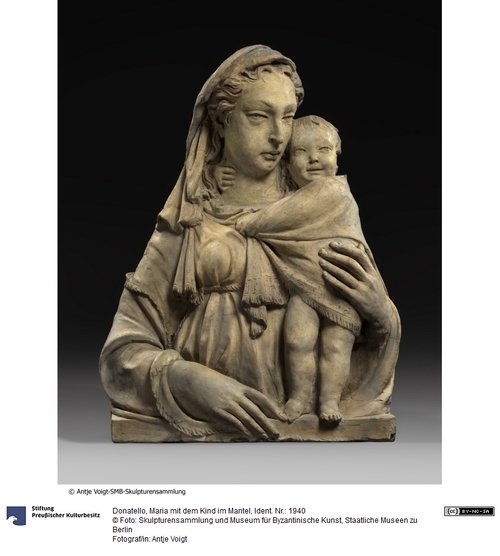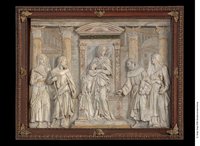Zusammen mit den mandelförmigen Augen der Jungfrau zeigen die überlängten Proportionen der Figuren, dass das Werk in einer Zeit geschaffen wurde, als der junge Donatello noch von der Gotik beeinflusst war. Die Originalität des Künstlers ist jedoch bereits in der dynamischen Haltung des Kindes sichtbar, und in der Art, wie das Relief viel tiefer erscheint als es tatsächlich ist.
Erworben 1892
Together with the almond-shaped eyes of the Virgin, the elongated proportions of the figures indicate that the work was created at a time when the young Donatello was still under the influence of Gothic taste. Yet the originality of the artist is already visible in
the dynamic pose of the Child, and in the way the relief appears much deeper than it actually is.
--
Attributed to Donatello
Virgin and Child
ca. 1410-15
Terracotta, formerly painted
90 x 67.5 cm
Berlin, Staatliche Museen, Skulpturensammlung, Inv. SKS 1940.
Bode-Museum, on view.
Provenance
Florence (1892); Berlin, Skulpturensammlung/Altes Museum (1892-1904); Berlin, Skulpturensammlung/Kaiser-Friedrich-Museum (1904-1939); Berlin, storage (1939-1945); Soviet Union, secret storage (1945/46-1958); East Berlin, Skulpturensammlung/Bode-Museum (1958-1990); Berlin, Skulpturensammlung/Bode-Museum (1990-present).
Acquisition
Acquired in Florence in 1892, gift of Oscar Huldschinsky.
Restorations
1958; 1977-78; 2009.
Exhibitions
Schätze der Weltkultur von der Sowjetunion gerettet, East Berlin, National-Galerie and Pergamonmuseum, 1958, cat. D 47.
Versions
• Bologna, Palazzo Grassi (formerly Tribunale Militare).
• Formerly Bologna, Caprara Orléans collection.
Comment
This Virgin and Child is a masterpiece of Florentine sculpture from the beginnings of the 15th century – when terracotta was once again used in Italy after a long period of disinterest. The Virgin and the Child are not looking at each other, but at the beholder; however, they are closely linked: the standing Child (supported by the Virgin’s left hand) has flung his right arm around his mother’s neck, while his left arm is covered by her veil (this veil has often been seen as a mantle, hence the name of the composition proposed by Knuth 1990 and Jolly 1998). Tschudi 1892 notes ancient traces of color on the relief; in any case, the paint on the Virgin’s eyes visible in pre-WWII photographs is a modern addition. The current absence of color allows the modeling to be fully appreciated. The fringes of the folds are especially well rendered, as is the drapery in general, through which the anatomy of the figures remains visible – an aspect that was not frequent in early 15th-century Florence. The Virgin’s hair and hands, or the Child’s legs seems to indicate that the work was modeled and not cast from a mold (the deep hollows in the Virgin’s hair also support this judgement).
The relief allegedly comes from a villa near Florence, where it was acquired by the Berlin Museums through the Florentine dealer Stefano Bardini with funds provided by Oskar Huldschinski (Bode 1899; the work is sometimes called the Huldschinski Madonna even if it was never part of the rich collection of the entrepreneur). This provenance may explain why the attribution of the work mostly focused on Tuscan artists, while another version of the Madonna, located in the Palazzo Grassi, Bologna, had made Bode 1891 think of Niccolò dell’Arca (see also Malaguzzi Valeri 1932-33, who published the third known version, then also in Bologna, and attributed it to the school of Niccolò dell’Arca). Bode 1899 first proposed that the work was by one of the many Tuscan masters active in Central and Southern Italy. Schottmüller 1913 grouped the work with the Crowning of the Virgin from Santa Maria Novella in Florence now attributed to Dello Delli. In a groundbreaking article, Bode 1914 grouped several Virgin and Child versions in terracotta, including this one, under thename of Lorenzo Ghi
Entstehungsort stilistisch: Florenz
de

